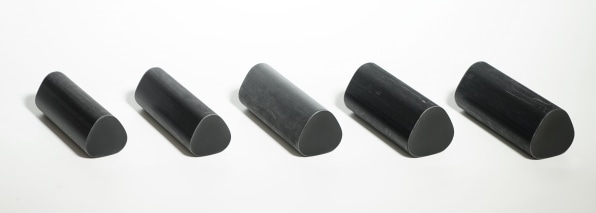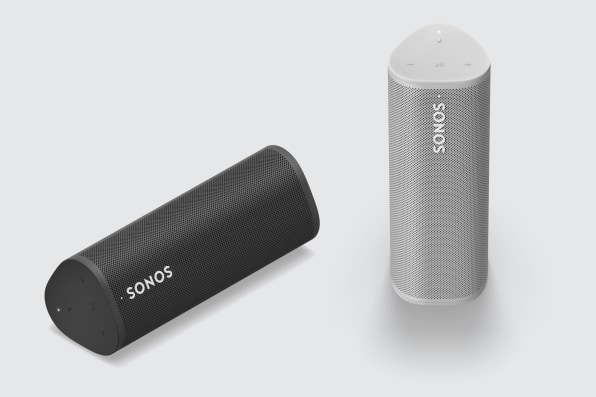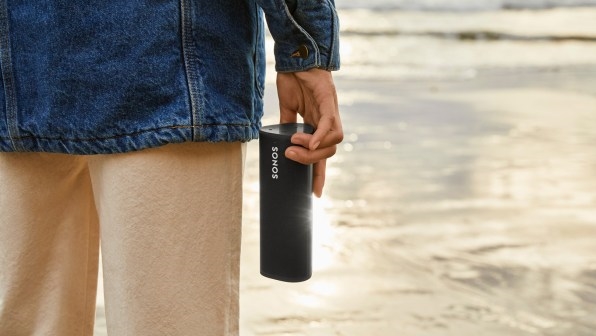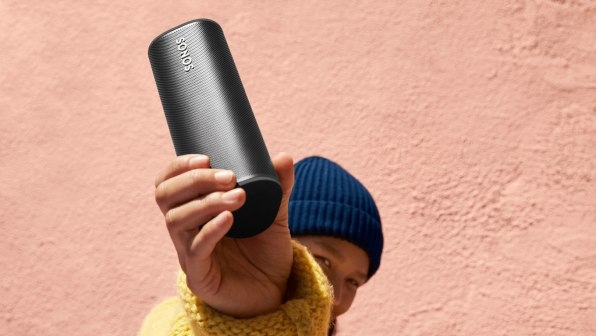Before there were Amazon Echos or Google Homes, Sonos created the entire category of wireless, networked speakers for your home. But after nearly 20 years in business, Sonos is finally releasing a speaker that you can take to the beach.
The Sonos Roam, the company’s first portable Bluetooth speaker, will be priced at $169 when it’s released on April 20. The design is smaller than a water bottle and waterproof up to three feet. But its more notable feat is how Sonos has designed the product to live two lives—either on your counter or on the go—while seamlessly sharing music to other Sonos devices along the way.

Sonos has struggled to remain enticing as tech giants subsidize their digital assistants to bargain-bin prices. The company has actually filed multiple lawsuits against Google alleging patent infringement. But Sonos does seem to have secured a niche of loyal users. Once they buy one Sonos product, they are likely to buy more. And that played out over 2020 with COVID-19. As most of us were stuck at home, Sonos sustained steady 15%-20% growth—even while facing supply-chain issues. The Roam marks the company’s inevitable foray into the $4.7 billion portable-speaker market.
“It’s a balance,” says Kate Wojogbe, UX director at Sonos. “We want this to be great for adding to your system, and we want it to be that gateway in [to the Sonos ecosystem].”

The triangular design
Developed over the course of more than two years, and involving hundreds of prototypes, the Sonos Roam is reminiscent of competitors such as the UE Boom. But it still manages to be a unique product.

[Photo: Sonos]
“While a lot of portable speakers spend more time indoors than outdoors, most don’t look like they belong in your home,” says Aki Laine, senior design manager at Sonos, who led Roam’s industrial design. “They look sporty and very durable, like you take the design of a power tool—very bombastic.”
Instead, the Roam is available in two monochromatic colors: white and black, so it matches the rest of the Sonos line in its attempt to disappear into your space. Meanwhile, Roam’s shape eschews common rectangles and cylinders for a triangular prism.

Sonos argues that the triangle design allows for a surprising amount of flexibility in different environments. Indoors, Laine points out that many people will place a portable speaker in their kitchen and bathroom, where counter space is always tight. In these spaces, the Roam can sit vertically, and its three-sided design allows it to slide all the way into a corner. The end caps are silicone, which makes it stick and balance a bit better on surfaces.
Outside, like on a bumpy picnic blanket or a soft pile of sand, the Roam is designed to sit horizontally (small feet on the device signal which side should go on the ground). With this arrangement, the speakers themselves always project sound via a facet that points upward. Meanwhile, onboard AI analyzes the speaker’s environment, optimizing the balance to match.

The intuitive experience
However, the most compelling part of the Sonos Roam is its promise of seamless music in and out of your home without worrying about the how or the why behind it all. Sonos speakers traditionally require Wi-Fi connections to stream music from the cloud. The Roam is the second Sonos device to add Bluetooth (which allows you to stream audio straight from your phone). Sonos’s biggest new promise is that the Roam can jump between Wi-Fi and Bluetooth connections effortlessly, instantly, and intuitively.

That means if you’re listening to the Roam streaming from your phone outside, you can carry it into your house, long-press a button on the device, and shoot your music over to your nearest Sonos speaker. Or you can stand by your Sonos speaker installed in your house, press on the Roam, and steal the installed speaker’s sound to take with you outside. You can grab music from a service such as Spotify, or if you have a Sonos TV soundbar, you can actually extend the audio of something like a baseball game to the Roam. Through all this, you should never need to pull out your phone and curse at why the music isn’t pairing properly, because the Roam and other Sonos speakers use inaudible, ultrasonic frequencies to talk to one another and sync up.

“It feels pretty natural,” says Wojogbe. “It uses proximity to know which speaker to throw it to. If I’m in the kitchen, it knows I’m in the kitchen.”
On paper, the Roam is promising. It’s a subtly ambitious product that’s trying to wrap complex digital services into a few mindless gestures. But we have yet to try it for ourselves. The Roam’s real value will come down to how good it actually sounds and how efficiently it actually juggles audio from device to device.
(56)